How to use ChatGPT to write a blog
Tempted to use the new AI technology like ChatGPT or Google Bard to write a blog for you? Discover the downsides to avoid, and how to use it to write quality content.
Over the past few months AI technology has gone mainstream, and tools like ChatGPT and Google Bard have become increasingly popular tools, particularly in business. You can even use an AI video generator. As a result, people are finding many different ways they can use the technology to speed up processes and reduce work.
So what exactly are ChatGPT and Google Bard? Let’s look at how the technology was developed and what it does – then find out if you can really use it to take the hard work out of writing a blog.
What is ChatGPT and how does it work?
Launched in November 2022 by OpenAI, a research company backed by Microsoft, ChatGPT is a chatbot answers questions and writes text.
Fundamentally, ChatGPT is a language model that is designed to predict the likelihood of a given sequence of words. By processing huge amounts of text from a wide range of sources, including books, websites, and social media, ChatGPT learns the patterns and structures of natural language.
This then allows ChatGPT to create responses that are often indistinguishable from text written by a human. ChatGPT is constantly learning and improving, too. As it processes more text and interacts with more users, it’s refining its responses and becoming more and more sophisticated in its understanding of natural language. There are other companies now, like this ChatGPT alternative, that use the same technology and have even improved on it as well.
What is Google Bard?
Google Bard is Google’s experimental, conversational AI chat service. Announced in February 2023 by Google and Alphabet CEO Sundar Pichai, Bard works in a similar way to ChatGPT. The biggest difference between the two, though, is that Bard pulls its information from the web.
While Bard itself may be new, it is powered by Google’s Language Model for Dialogue Applications (LaMDA), which was built on Transformer, Google’s neural network architecture that it invented and open sourced in 2017. According to Google, GPT-3, the language model ChatGPT uses, was also built on Transformer.
What are people using ChatGPT for?
You can use ChatGPT and Google Bard for many purposes. According to research by AuthorityHacker, here are some of the most popular AI use cases:
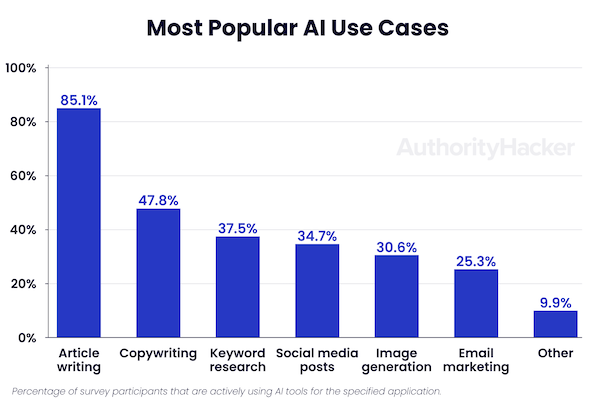
How can you use ChatGPT to come up with blog ideas?
As you can see, one of the most popular uses for small businesses, bloggers and content creators right now is to use ChatGPT as a writing tool to generate ideas and content for articles and blogs. So, for example, you might ask ChatGPT or Google Bard to write a blog, social media post or email, or come up with ideas for a whitepaper or webinar.
They are also very handy tools to use to come up with blog ideas. Here’s what Google Bard came up with when I asked it to suggest blogs ideas on the topic of copywriting. Here’s my question:

And here are Bard’s suggestions:

Here’s what ChatGPT came up with for the same question:
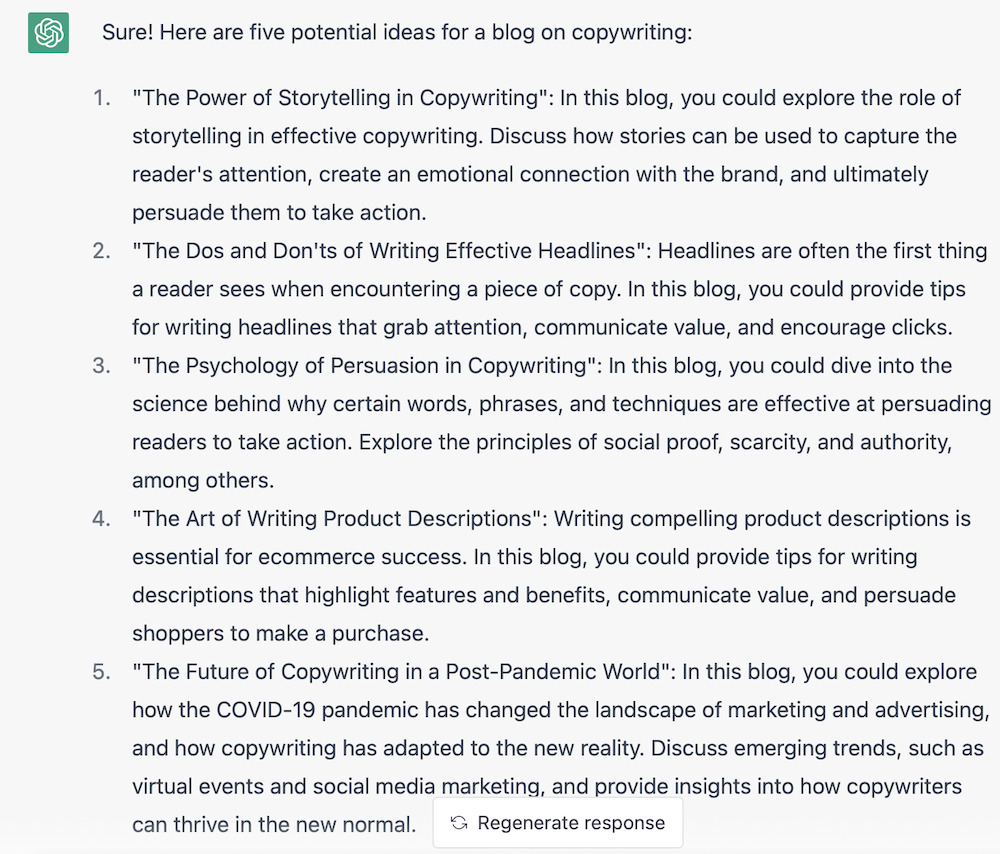
As you can see, neither ChatGPT or Google Bard just suggest a title. Instead they also include ideas for the content. If you wanted you can simply stop here and use ChatGPT or Google Bard as inspiration for ideas, if you are stuck.
But you can go one step further and actually get Google Bard or ChatGPT to actually write your blog for you.
Ask ChatGPT to come up with SEO keywords for your blog
You can also use ChatGPT or Google Bard to come up with SEO keywords for your blog or content. Just ask it something like:
Give me a list of 10 low-competition keywords related to [subject]. Show the data in a table with the keywords ranked by popularity.
You’ll then see a table that looks like this:
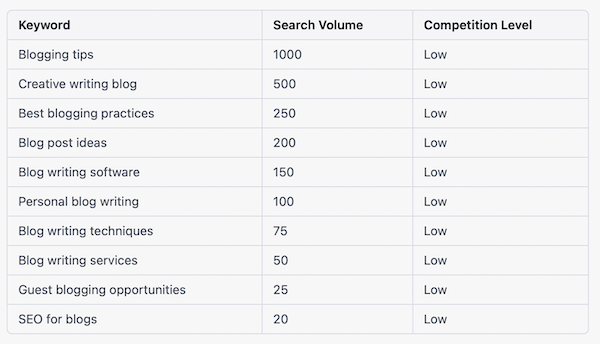
It is important to remember though (as we’ll cover in more depth later) that you cannot rely on AI tools for accuracy. Indeed, ChatGPT caveats their answer with this line:
Note: The search volume and competition levels are estimates and may vary depending on location and other factors.
And Google Bard warns:
Please note that these keywords are subject to change, and the competition for them may vary depending on the time of year and the popularity of the topic.
When I tried asking ChatGPT and Google Bard the same question, they came up with different keywords. And any keywords that were the same in both lists had different search volumes!
So do feel free to use ChatGPT or Google Bard for keyword inspiration, but don’t rely on it as being 100% accurate.
It’s worth noting here that it is important to ask the right question – this is known as a ChatGPT prompt. Like any resource, the more perfect your ChatGPT prompt, the better the response you will get.
How to get ChatGPT to write a blog for you
So now your have your blog idea and keywords, what next? Can ChatGPT, Google Bard or another AI text generator actually write the whole blog for you?
It turns out yes, they can. To get ChatGPT or Google Bard to write a blog or content for you, all you need to do is ask it. Use commands like:
- Write a blog about copywriting
- Write a blog titled What is copywriting?
- Write a 600 word blog about how to be a copywriter
- Write a blog about copywriting using the keyword
Then just wait a few seconds, and a blog will magically appear on your screen. All you then need to do is copy the text and paste it into your website and publish.
Or do you? Can it REALLY be that quick and easy to generate content today? Before you hit publish, it’s a smart move to run the content through Humanize AI to make sure it sounds natural and connects better with your readers.
Four reasons why you should be careful when using ChatGPT to write content for you
Like all gift-horses, it pays to look AI technology in the mouth. Because while it may be free and fast, there are some downsides to using ChatGPT or Google Bard to generate content. Downsides that mean we don’t recommend simply copying and pasting its results.
Here are four reasons why you should be careful when using ChatGPT or Google Bard to write content for you.
1) ChatGPT generated content isn’t unique
I’ve tested asking both ChatGPT and Google Bard to write blogs on the same subject a few times. And I have noticed that the results are very similar. And when searching for chunks of the text they produce online, I have found the same, or very similar copy already published.
This isn’t great for your reputation, if that is important to you. You can’t claim to be an expert on something if you are found to have replicated or used text someone else has already written (or is obviously written by AI). It’s also not good for SEO, as Google likes original text. If it finds pages with duplicate text, it won’t serve both in results for the same search terms.
This is a big reason why you need to write, or at best significantly edit, blogs yourself, rather than relying on AI to do all the work for you. To ensure any content is unique, you can use tools like Originality.ai as an AI detector to check ChatGPT generated text and AI plagiarism. Other AI detector tools include ZeroGPT.com and Uncheck AI.
2) ChatGPT generated content might not be accurate
You also cannot rely on AI like ChatGPT or Google Bard to be accurate. After all, they are chatbots searching and processing vast amounts of text. They have no knowledge or expertise themselves, and certainly no lived experience, so cannot assess what is true or not. OpenAI even openly admit that ChatGPT makes mistakes:
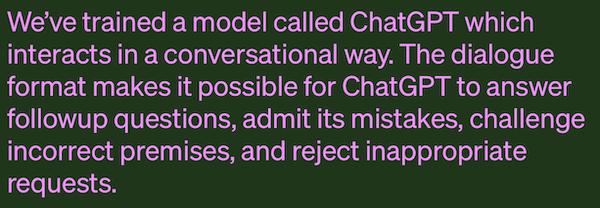
ChatGPT is even potentially being sued by a mayor in Australia, after the chatbot made false claims that he had served time in prison for bribery. The mayor’s lawyers sent a letter of concern to OpenAI, the owners of ChatGPT on 21 March, giving them 28 days to correct the mistakes, or face a possible defamation lawsuit.
So yes, ChatGPT or Google Bard may save you hard work by writing a blog for you in seconds, but you have no idea if the blog is correct, or even makes sense. You will need to check it thoroughly, and must have knowledge of the subject in order to spot something that is wrong or even nonsensical.
3) ChatGPT generated content doesn’t link sources – or give you correct references
Another failing of ChatGPT and Google Bard is that they will quote people and figures without referencing where they found them. This means that, leading on from the last point, you can’t check whether they are correct or up to date. It also means that you can’t properly attribute them in your blog, which is best practice for ethics, usefulness for your readers, and that all-important SEO.
In testing out both ChatGPT and Google Bard I have been quoted figures that I have not been able to find sources for. I haven’t even been able to find any website mention them. It’s almost like they were plucked out of thin air.
I’m not the only one to notice this. The author of this post asked ChatGPT to provide references that deal with the mathematical properties of lists. The results it provided looked legitimate:

However, when the author tried to verify them, they couldn’t:
“… it turns out that every single one of those references and links are made up. The references don’t exist and the links themselves appear to be cobbled together. The last link for example, takes you to a paper on “Grain mixes for subgrade layers” – the title in the url is irrelevant and only the number matters.
“Googling for some of those authors throws up author pages with their publications, and it turns out they’ve never published papers with those titles!”
So not only does ChatGPT not link sources, but when you ask for references, you can’t rely on its answers! If you want to include figures and quotes in your blogs and content, you need to find them yourself.
4) ChatGPT generated content doesn’t have your tone of voice
And finally, while AI might be able to write a blog for you in seconds, it won’t necessarily sound like you. All the content we have seen it create has had a very similar tone of voice.
There’s so much more to communication than simply constructing a message – how you convey that message is often just as important as what you are actually saying. Tone of voice is extremely important for building your brand, too.
There’s also a certain ‘robotic-ness’ to the content that AI like ChatGPT and Google Bard generate. Like Spock from Star Trek, they may be able to convey information, but there’s no emotion behind it, and it can sound a little cold and flat – even when they are using humour.
They also lack the nuances and lived-experiences insights that humans rely on when coming up with content ideas or blog copy. For example, here’s what ChatGPT came back with when I asked it for blog titles for mum style:
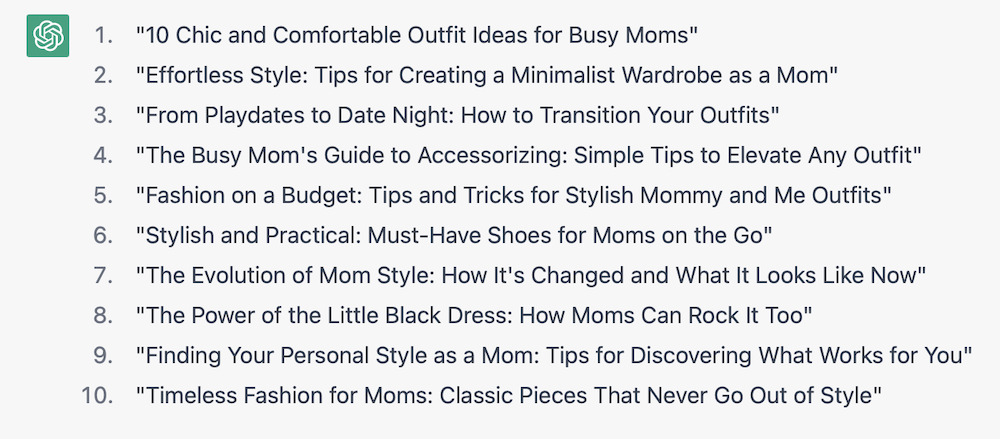
One of our most popular blogs in the early years was How not to dress like a mum. I’m not sure that ChatGPT or Google Bard would be able to come up with a title like that right now – their ideas are just a bit flat and dull.
So if you want your blog to sound like you or your business, you will still need to rewrite what ChatGPT or Google Bard write for you. And if you want a blog that will really connect with your audience and stand out from your competitors, you will probably need to come up with the title yourself.
How to use ChatGPT to write an accurate, unique blog that sounds like you
Given these downsides, should we give up on using AI like ChatGPT and Google Bard to write blogs? The answer is yes – and no.
If you are a serious writer, and have a unique message to convey based on personal knowledge and experience, it will always be better to write your content yourself – as I have written this blog myself, with no help from AI tools.
But if you need to write blogs for your business and don’t have the time, expertise, or desire to come up with ideas and content yourself, AI is a handy tool that can make the process quicker and easier for you. To bridge the gap, platforms like Humanize AI help ensure the generated content feels authentic, adding depth and a personal tone that aligns with your brand. And if that means the difference between having regular content for your website and not being able to update your site, using it is a no-brainer.
But there are some recommendations we’d set when using it.
Yes, use ChatGPT or Google Bard to come up with blog ideas and blog titles, but treat these as a starting point for inspiration. Can you come up with more interesting or more personal ideas? Can you improve what AI came back with? Their ideas tend to be quite basic and vanilla, so it is definitely worth putting some thought into them.
If you are stuck for ideas for content and structure for your blog, you can ask ChatGPT or Google Bard to write it for you. But treat this as an early first draft, rather than the finished piece. Read through it and see how you can edit it to make it your own. Use your own experience, include your own illustrative examples, source your own data and quotes, and weave through your own tone of voice and SEO keywords.
And if ChatGPT or Google Bard comes up with figures or quotes, research them and include an authority source in your blog. If you can’t find a trusted source, don’t use the figures or quotes, however brilliant they may be. Without verification you have no idea if they are true or not.
Plus, as well as editing for tone of voice, re-work the blog so it is unique. Ensure that you don’t simply copy across chunks of text without changing it. This is especially important if you want your content to rank for SEO.
ChatGPT won’t take ALL the hard work of blog writing away
In summary, I believe that AI tools like ChatGPT and Google Bard can be fantastic shortcuts for writing blogs and online content, especially now that there’s even free chat gpt app available. But you need to use them with caution. And don’t assume that they are going to take all the hard work away.
If you want quality content that is unique, accurate, sounds like you, really connects with your readers, and might rank for SEO, you’ll have to put in some effort too.
Photo by Jonathan Borba




